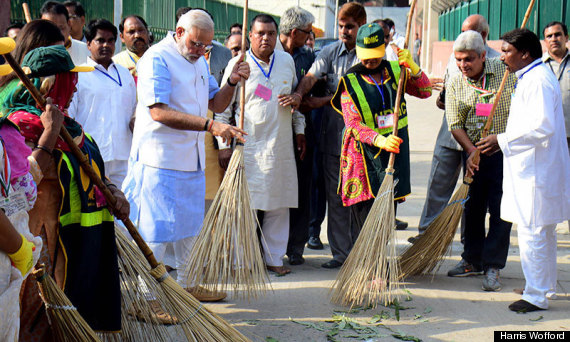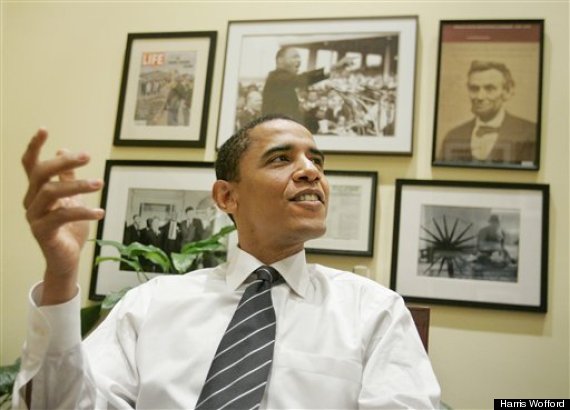Last month, at the end of his successful first visit to the United States, Prime Minister Modi and President Obama together paid tribute to Martin Luther King at Washington's recently built memorial to the icon of American nonviolence. On his first day back in India, Gandhi's 145th birthday, Modi asked for a broom and began his Swachh Bharat (Clean India) campaign by publicly sweeping at the impoverished Valmiki Colony in Delhi. He ordered government ministers to join the campaign, saying, "Gandhi gave us the slogan: 'Quit India' and people came together to win our country's freedom... but his other dream... of 'Clean India' is still incomplete."
The Prime Minister's campaign draws strength from Gandhi's own example of direct action. In The Story of My Experiments With Truth, Gandhi described his first meeting of the Indian National Congress in Calcutta in 1901, when he had returned for a few years from South Africa. "There was no limit to insanitation... There were only a few latrines, and the recollection of their stink still oppresses me," Gandhi wrote. "I asked for a broom. The man stared at me in wonder. I procured one and cleaned the latrine... I found no one to share the honor with me of doing it."

In South Africa, he had asked his followers to take immediate action to clean their own streets and homes. After he returned to India permanently in 1915, he went to the Congress and he again shocked the delegates there by asking for a broom and cleaning the latrines. Some delegates responded that sanitation was a problem the government should deal with after independence. Gandhi's response was simple: "Why wait till the advent of swaraj for the necessary drain-cleaning?"
Gandhi was a master of political symbols, as Modi's broom may now become. But too often 21st-century references to Gandhi treat him just as a symbol, rather than a source of political wisdom. This impedes learning from his successes, and recognizing, as he did, his major failures. Gandhi considered his greatest failure to be Partition itself, as well as the riots that broke out before and after independence. "Vivisect me before you vivisect India," he pleaded. Gandhi also lamented that he failed to convince the Indian National Congress to dissolve as a political party and transform itself into a constructive force for service in the villages and cities of India.
Soon after his death, I arrived in India in 1949 with my wife for a yearlong fellowship on Gandhi's trail. By then, his plan for swaraj had become encapsulated into a simple formula: the Spade, the Prison, and the Vote. Gandhi acknowledged that England and the West had been pioneers when it came to the Vote, and that India needed free elections. But he placed equal importance on the other two dimensions of successful self-government: The first was Non-Violent Direct Action, saying 'No' and, if necessary, going to jail to demonstrate that particular laws or actions were unjust. The other side of the coin of direct action, he said, was Constructive Service -- saying 'Yes' by taking up the spade and institution-building in service to the community.
Our arrival in India in 1949 was my second visit to the Subcontinent. In 1938, at age eleven, I had been lucky to travel around the world for six months with my grandmother on the eve of World War II, including nearly a month's time in India, by far our longest stop. I had a high fever at our hotel in then-Bombay fighting tonsillitis when word spread that Gandhiji would soon be passing nearby on his way to the beach for a mass prayer meeting. I was disappointed to be unable to join the crowds, but from our hotel window we were lucky to catch a sight of Gandhi as he passed by. Seeing him, and then hearing about him everywhere we went,stirred a lifelong curiosity.
When we returned eleven years later, I was eager to understand more deeply Gandhi's political strategy. We followed his path from the ashram at Sevagram to the creation of an opposition party, formed under Jayprakash Narayan at Patna and increasingly committed to a Gandhian strategy. We also interviewed Prime Minister Nehru, by then a tired and seemingly sad man, at his office at the Secretariat. He gently asked us about what we had seen in India, and would take back to the United States. In the book my wife Clare and I co-wrote, India Afire, we described the Nehru we met as "the most weary man on earth."
From Nehru and Gandhian leaders to ordinary Indians in villages, cities, and on trains across the nation, we were asked continually about the deep moral stain of racial discrimination in the United States, an issue I had previously unduly ignored: "What have you done about segregation in the United States? Have you been to jail to oppose it?" I realized that Gandhi's powerful way of saying "No" could and should be applied to the American civil rights movement, and returned home determined to become involved in that movement, doing whatever I could to spread Gandhi's strategy of nonviolence in the United States.
At the same time in 1949 that I was reading Gandhi's works in Bangalore, a young American preacher, Martin Luther King, was reading them at Crozer Seminary outside Philadelphia. He later read with interest a speech of mine advocating Gandhian tactics, and I became a friend and informal advisor on the ways and means of bringing Gandhi's ideas to the United States. King later joked that Harris Wofford was the one volunteer lawyer on his team who would "help me go to jail, rather than using all the tricks of the trade to keep me out."

King and his wife Coretta visited India in 1959, at my suggestion and with the help of many others, including a special invitation from Nehru. Upon being asked to visit the United States and spread his message there in 1935, Gandhi had said, "How I wish I could, but I must make good the message here before I bring it to you. It may be that through the American Negro the unadulterated message of nonviolence will be delivered to the world."
King delivered that message, and the power of saying 'No,' has been heard around the world. But the other half of Gandhi's work -- saying 'Yes' and taking constructive action -- has not yet found its Martin Luther King. After the election of Barack Obama, I took my most recent of some ten trips to India with civil rights champion Congressman John Lewis and Martin Luther King III. It was the 50th anniversary of King's visit there, and the American and Indian governments were opening an exhibit on the American Civil Rights movement and its connection to Gandhi, including a giant photograph of newly elected President Barack Obama behind his desk in the Senate. On the wall behind him were the photos he wanted to see every day when he came to work -- Abraham Lincoln, Mahatma Gandhi at his spinning wheel, John Kennedy, and Martin Luther King.
Since independence, India has used the vote, as Gandhi foresaw, in successful free and fair elections by the world's largest democracy. It has been 76 years since I saw Gandhi pass by. Now you in India, and we in America, have an opportunity to take up the Spade and show how to say 'Yes.' We should hope that Prime Minister Modi's broom will not only be a symbol of what could be, but will stir the Indian people to rise together with the power of all three forms of swaraj, improving their own communities and then, through their example, the world.
This blog post is part of a series produced by The Huffington Post in conjunction with the launch of HuffPost India (December 8, 2014). To read all posts in the series, visit here.